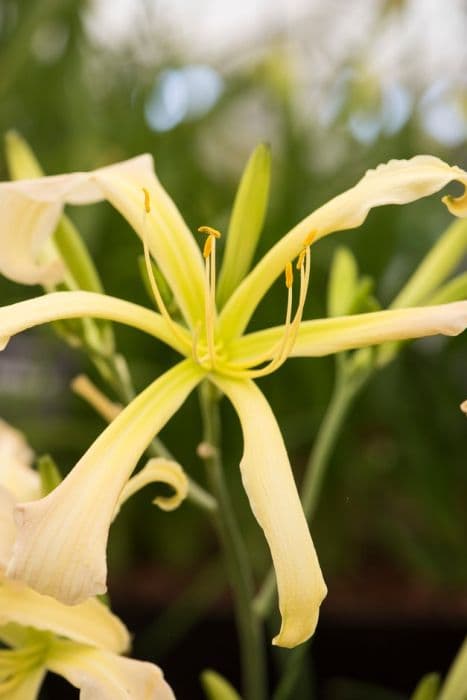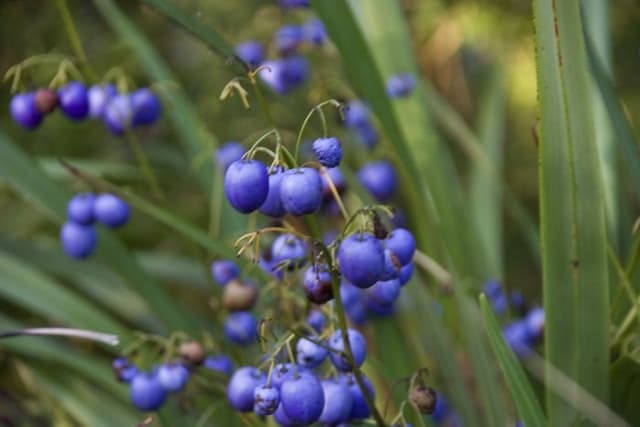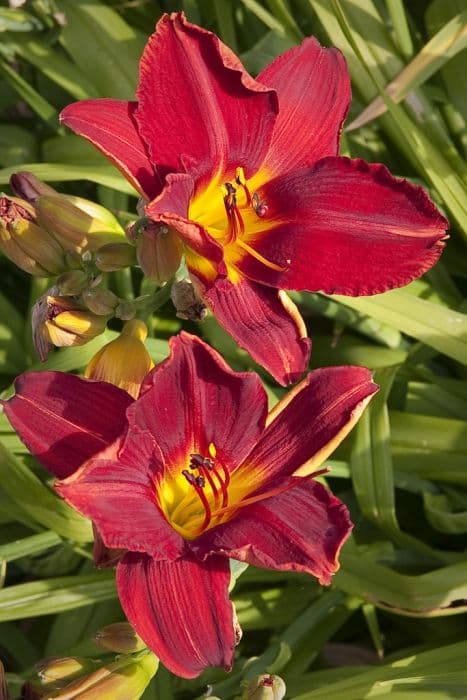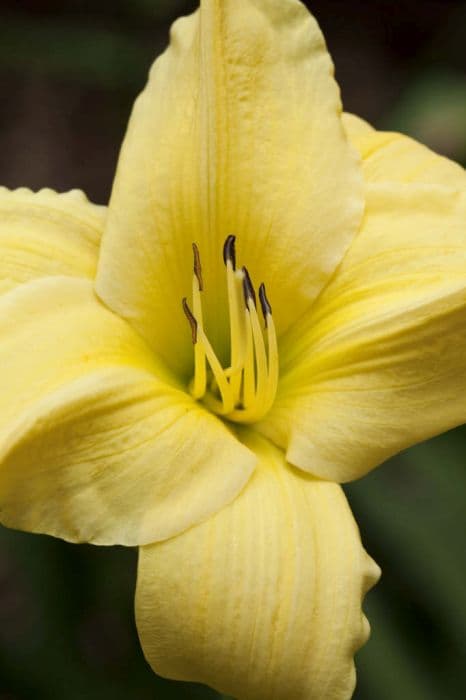Dumortier's Daylily Hemerocallis dumortieri

ABOUT
The plant commonly known as Dumortier's daylily features a striking and graceful appearance. It is adorned with a profusion of vibrant, trumpet-shaped flowers that come in shades of yellow and orange, often with a subtle flush of brown or red on the petals. These blossoms exhibit a soft, wavy edge and have six distinct segments, with a deeper colored midline known as a "throat" running down the center of each petal segment, providing an attractive contrast. The flowers are borne on long, slender stalks which emerge from a lush clump of foliage. The leaves themselves are long, narrow, and arch gracefully, resembling blades of grass in their form and texture. This greenery forms a dense tuft at the base of the stalks, creating a backdrop that showcases the delicate beauty of the blossoms perched above. This daylily is known for its hardiness and for the fact that each individual flower typically lasts just one day, with new blooms continually opening over the course of the blooming period. In the heart of the flower, there are six stamens that surround a single, prominent pistil, typical of lily-like plants. After the flowering period, the plant may produce capsule-like fruit, but it is the flowers that are the main attraction during its bloom time.
About this plant
 Names
NamesFamily
Hemerocallidaceae
Synonyms
Dumortier's Daylily, Early Daylily, Grassleaf Lily
Common names
Hemerocallis esculenta, Hemerocallis dumortierii, Hemerocallis esculenta var. dumortieri
 Toxicity
ToxicityTo humans
The plant commonly known as daylily is not considered toxic to humans. In fact, some cultures eat the flowers, buds, and tubers. However, any plant material can potentially cause a reaction in sensitive individuals, such as nausea, vomiting, or diarrhea, but this is not common and the daylily is typically not regarded as a poisonous plant to humans.
To pets
The daylily is toxic to cats and may cause symptoms of poisoning if ingested. The plant contains certain components that can be harmful, and ingestion can lead to kidney failure in cats. Symptoms of poisoning might include vomiting, lethargy, kidney failure, or death. Pet owners should prevent their cats from having access to daylilies.
 Characteristics
CharacteristicsLife cycle
Perennials
Foliage type
Deciduous
Color of leaves
Green
Flower color
Yellow
Height
1-2 feet (30-60 cm)
Spread
1-2 feet (30-60 cm)
Plant type
Herb
Hardiness zones
4
Native area
Asia
Benefits
 General Benefits
General Benefits- Landscape Decoration: Daylily's vibrant yellow-orange flowers can enhance the aesthetic appeal of gardens and landscapes.
- Drought Tolerance: Daylilies are known for their ability to withstand periods of low water availability, making them suitable for xeriscaping and low-maintenance gardens.
- Easy Propagation: They can be easily propagated by division, allowing gardeners to multiply their plants and fill garden spaces economically.
- Pest Resistance: Daylilies are relatively resistant to pests and diseases, reducing the need for chemical interventions.
- Soil Erosion Control: The dense foliage and root system of daylilies help prevent soil erosion, especially on slopes and in areas with loose soil.
- Widely Adaptable: They thrive in a diversity of soil types and environmental conditions, making them versatile additions to many garden settings.
- Long Blooming Period: Daylilies have a prolonged blooming season, often producing flowers for several weeks in the summer.
- Support for Wildlife: The flowers attract pollinators such as bees and butterflies, contributing to the health of local ecosystems.
- Culinary Uses: Some parts of daylilies are edible and are used in certain cuisines, providing an ornamental plant that can also contribute to culinary diversity.
 Medical Properties
Medical Properties- Anti-inflammatory: Hemerocallis dumortieri has been traditionally used to reduce inflammation in various conditions.
- Analgesic: There is some evidence suggesting that it may have pain-relieving qualities.
- Antispasmodic: The plant might be used to relieve muscle spasms or cramps.
- Fever reducer: It may help in reducing fever, though more research is required to confirm this use.
- Laxative: Hemerocallis dumortieri could be utilized to treat constipation, promoting bowel movements.
 Air-purifying Qualities
Air-purifying QualitiesThis plant is not specifically known for air purifying qualities.
 Other Uses
Other Uses- The daylily's fibrous roots can help with soil erosion control by stabilizing the soil on banks and slopes.
- In certain cultures, the daylily is a symbol of motherhood and is used in festivities celebrating mothers and motherhood.
- Daylily flowers can be used as natural dyes for fabrics, providing a range of yellow, orange, and green hues depending on the mordant used.
- The blooms are sometimes used in the ornamentation of dishes and cocktails in high-end culinary presentations for their aesthetic appeal.
- Daylilies can be planted in septic drain fields as their root system is non-invasive and they can tolerate the conditions well.
- The daylily's attractive foliage and dense clumping habit make it a suitable living mulch, suppressing weeds around other plants.
- The dried stalks and leaves can be used as a source of natural fiber in basket weaving or as a component in handmade paper.
- Some gardeners use daylilies as companion plants to deter certain pests from more sensitive vegetables and flowers.
- The flowers are sometimes crystallized and used as edible decorations for cakes and desserts.
- In landscape design, daylilies are used to create a natural transition between formal garden areas and wilder parts of a property.
Interesting Facts
 Feng Shui
Feng ShuiThe Daylily is not used in Feng Shui practice.
 Zodiac Sign Compitability
Zodiac Sign CompitabilityThe Daylily is not used in astrology practice.
 Plant Symbolism
Plant Symbolism- Endurance and Survival: Hemerocallis dumortieri, commonly known as Dumortier's daylily, often symbolizes endurance and survival due to its ability to thrive in a variety of conditions and its resilience to environmental stresses.
- Motherhood: The daylily is sometimes associated with motherhood because of its nourishing tubers and its long history of cultivation for both ornamental and medicinal purposes.
- Beauty: Daylilies, with their striking and vibrant blooms, are often symbolic of beauty and the transient nature of attractiveness, as each individual flower typically lasts only a single day.
- Transience of Life: Reflecting on how each flower only blooms for a day, Dumortier's daylily represents the ephemeral nature of life, reminding us to cherish every moment.
- Forgotten Love: In Victorian flower language, daylilies can signify a lost or abandoned love due to the fleeting lifespan of the flowers, symbolizing affection that has passed.
 Water
WaterDaylilies, including Hemerocallis dumortieri, prefer consistently moist soil, so regular watering is important, particularly during dry spells. Water the plant once a week with about one inch of water or roughly 0.62 gallons per square yard, ensuring you're moistening the soil thoroughly to a depth of at least six inches. In periods of extreme heat or drought, you may need to water more frequently, monitoring the soil moisture and providing additional water if the top few inches of soil become dry. It's best to water the daylilies early in the morning, which allows the foliage to dry throughout the day, reducing the risk of fungal diseases.
 Light
LightDaylilies thrive in full sun to partial shade. For optimal growth, Hemerocallis dumortieri should be placed in a spot where it receives at least six hours of direct sunlight each day. However, in extremely hot climates, some afternoon shade can help protect the plant from excessive heat. Avoid deep shade, as it can result in fewer blooms and weaker growth.
 Temperature
TemperatureDaylilies are hardy and adapt to a wide range of temperatures, but Hemerocallis dumortieri grows best in temperatures between 60°F and 75°F. It can survive minimum winter temperatures down to about -20°F and is resilient during summer heat as long as proper watering is maintained. The ideal temperature conditions allow for a robust blooming period and healthy foliage.
 Pruning
PruningFor Daylilies such as Hemerocallis dumortieri, pruning, or more appropriately deadheading, is done to remove spent blooms and maintain a tidy appearance. After the initial blooming, cut back the flower stalks to the base to encourage new growth and potential rebloom. The best time for pruning is immediately after the flowers fade. Additionally, in late fall or early spring, remove any dead foliage to prepare the plant for new growth.
 Cleaning
CleaningAs needed
 Soil
SoilDaylilies prefer well-draining soil with a good mix of loam, peat moss, and sand, ensuring proper aeration and moisture retention. The soil pH should be slightly acidic to neutral, ranging from 6.0 to 7.0, optimal for Hemerocallis dumortieri growth.
 Repotting
RepottingDaylilies, including Hemerocallis dumortieri, do not require frequent repotting and can thrive outdoors without being moved for many years. Divide and repot every 3 to 5 years to maintain vigor and bloom quality.
 Humidity & Misting
Humidity & MistingDaylilies such as Hemerocallis dumortieri are adaptable to various humidity levels; however, they perform best in moderate humidity conditions and do not require any special humidity adjustments when grown outdoors.
 Suitable locations
Suitable locationsIndoor
Grow daylilies indoor in bright indirect light and well-draining soil.
Outdoor
Plant daylilies in sun to part shade, moist well-drained soil.
Hardiness zone
4-9 USDA
 Life cycle
Life cycleThe life of Hemerocallis dumortieri, commonly known as Dumortier's daylily, begins as a seed, which upon finding suitable conditions, germinates to produce a small seedling. The seedling grows into a clump of grass-like foliage as it establishes a root system and begins photosynthesizing to gather energy for growth. Over time, the plant enters a vegetative state where it grows larger and produces more foliage, storing energy in underground rhizomes. After reaching maturity, which may take several years, the daylily starts its reproductive phase, typically in late spring to early summer, sending up tall scapes that bear funnel-shaped, yellow to orange flowers. Each flower blooms for just one day, hence the common name "daylily," but numerous buds ensure a prolonged flowering period. After pollination, the flowers produce capsules containing seeds, completing the cycle, while the foliage dies back in the fall and winter, with the plant entering dormancy only to regrow the following spring.
 Propogation
PropogationPropogation time
Spring-Early Summer
The most popular method of propagating Hemerocallis dumortieri, commonly known as Dumortier's daylily, is through division. This technique is ideally performed after the plant has finished flowering, which is typically in late summer to early fall. To propagate by division, carefully dig up the clump of daylilies, ensuring to get as much of the root system as possible. Using a sharp spade or knife, divide the clump into smaller sections, each with several fans of leaves and a healthy portion of roots. The individual divisions should then be replanted at the same depth they were growing originally, spacing them about 12 to 18 inches (approximately 30 to 45 centimeters) apart to allow for adequate growth. Water the new plantings thoroughly to help establish them. Division not only helps to proliferate the daylily but also invigorates older clumps that may have become overcrowded, leading to better flowering and overall health.









